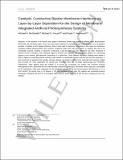| dc.contributor.author | McDonald, Michael | |
| dc.contributor.author | Freund, Robert Michael | |
| dc.contributor.author | Hammond, Paula T | |
| dc.date.accessioned | 2020-06-12T21:10:43Z | |
| dc.date.available | 2020-06-12T21:10:43Z | |
| dc.date.issued | 2017-11 | |
| dc.date.submitted | 2017-07 | |
| dc.identifier.issn | 1864-5631 | |
| dc.identifier.uri | https://hdl.handle.net/1721.1/125789 | |
| dc.description.abstract | In the presence of an electric field, bipolar membranes (BPMs) are capable of initiating water disassociation (WD) within the interfacial region, which can make water splitting for renewable energy in the presence of a pH gradient possible. In addition to WD catalytic efficiency, there is also the need for electronic conductivity in this region for membrane-integrated artificial photosynthesis (AP) systems. Graphene oxide (GO) was shown to catalyze WD and to be controllably reduced, which resulted in electronic conductivity. Layer-by-layer (LbL) film deposition was employed to improve GO film uniformity in the interfacial region to enhance WD catalysis and, through the addition of a conducting polymer in the process, add electronic conductivity in a hybrid film. Three different deposition methods were tested to optimize conducting polymer synthesis with the oxidant in a metastable solution and to yield the best film properties. It was found that an approach that included substrate dipping in a solution containing the expected final monomer/oxidant ratio provided the most predictable film growth and smoothest films (by UV/Vis spectroscopy and atomic force microscopy/scanning electron microscopy, respectively), whereas dipping in excess oxidant or co-spraying the oxidant and monomer produced heterogeneous films. Optimized films were found to be electronically conductive and produced a membrane ohmic drop that was acceptable for AP applications. Films were integrated into the interfacial region of BPMs and revealed superior WD efficiency (≥1.4 V at 10 mA cm⁻²) for thinner films (<10 bilayers≈100 nm) than for either the pure GO catalyst or conducting polymer individually, which indicated that there was a synergistic effect between these materials in the structure configured by the LbL method. | en_US |
| dc.description.sponsorship | National Science Foundation (Grant CHE‐1305124) | en_US |
| dc.language.iso | en | |
| dc.publisher | Wiley | en_US |
| dc.relation.isversionof | http://dx.doi.org/10.1002/cssc.201701397 | en_US |
| dc.rights | Creative Commons Attribution-Noncommercial-Share Alike | en_US |
| dc.rights.uri | http://creativecommons.org/licenses/by-nc-sa/4.0/ | en_US |
| dc.source | Prof. Hammond via Ye Li | en_US |
| dc.title | Catalytic, Conductive Bipolar Membrane Interfaces through Layer-by-Layer Deposition for the Design of Membrane-Integrated Artificial Photosynthesis Systems | en_US |
| dc.type | Article | en_US |
| dc.identifier.citation | McDonald, Michael et al. "Catalytic, Conductive Bipolar Membrane Interfaces through Layer-by-Layer Deposition for the Design of Membrane-Integrated Artificial Photosynthesis Systems." ChemSusChem 10, 22 (November 2017): 4599-4609 © 2017 Wiley-VCH Verlag GmbH & Co. KGaA, Weinheim | en_US |
| dc.contributor.department | Massachusetts Institute of Technology. Department of Chemistry | en_US |
| dc.contributor.department | Massachusetts Institute of Technology. Department of Chemical Engineering | en_US |
| dc.relation.journal | ChemSusChem | en_US |
| dc.eprint.version | Author's final manuscript | en_US |
| dc.type.uri | http://purl.org/eprint/type/JournalArticle | en_US |
| eprint.status | http://purl.org/eprint/status/PeerReviewed | en_US |
| dc.date.updated | 2020-06-08T15:45:24Z | |
| dspace.date.submission | 2020-06-08T15:45:26Z | |
| mit.journal.volume | 10 | en_US |
| mit.journal.issue | 22 | en_US |
| mit.license | OPEN_ACCESS_POLICY | |
| mit.metadata.status | Complete | |

